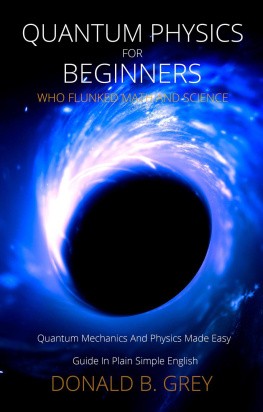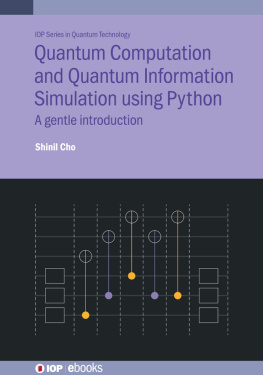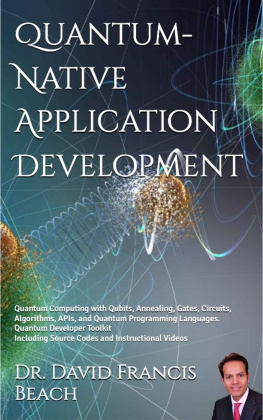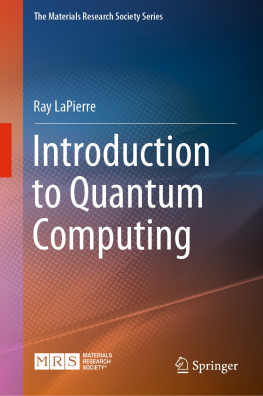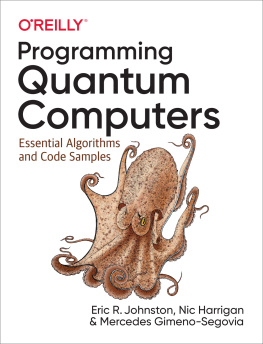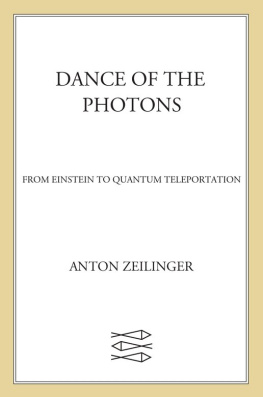Before presenting the main theme of this book, I would like to begin with two short stories that will help to set the scene. One is a true story about something that happened in the past, while the other is pure fiction, but might actually come about in the near future.
Newton: So Great an Absurdity
Everyone has heard of Newtons universal theory of gravity, according to which all objects attract one another in a way that depends on their masses and the distance between them (or more precisely, the inverse square of that distance, but that will not be important here). For example, the Sun and the Earth are bound together by an attractive force that balances the centrifugal force and holds the Earth on an approximately circular orbit around the Sun. The same goes for the other planets, for the EarthMoon system, and even for the whole of our galaxy, which revolves around the center of a cluster of galaxies.
But let us focus on the EarthMoon system. How does the Moon know that it must be attracted by the Earth in a way that depends on the mass of the Earth and the separation between the two? For that matter, how does the Moon know the mass of the Earth and its distance away from us? Does it use some kind of measuring stick, like the baby mentioned earlier? Or does it throw little balls of some kind? Indeed, does it communicate in some special way? This apparently childish question is actually deadly serious. In fact, it greatly intrigued Newton, for whom the hypothesis of universal gravitation, although he discovered it himself and it had brought him such fame, was so absurd that no healthy mind could take it seriously (see box below).
But for the moment, suffice it to say that Newtons intuition was correct, even though it took several centuries and the genius of Einstein to fill the conceptual gap and provide a satisfactory answer. Today, physicists know that the action at a distance which occurs in gravitation, or indeed in the interaction between two electric charges, is not altogether instantaneous. Rather, it results from the exchange of messengers, whence the little balls conjecture mentioned above turns out to be the right one. These messengers are tiny particles to which physicists attribute names. The messengers for gravity are called gravitons, while those for electric forces are called photons.
Box 1. Newton.
That Gravity should be innate, inherent and essential to Matter, so that one Body may act upon another at a Distance through a Vacuum without the mediation of any thing else, by and through which their Action and Force may be conveyed from one to another, is to me so great an Absurdity, that I believe no Man who has in philosophical Matters a competent Faculty of thinking can ever fall into it.
In this way, since Einstein, physics has described nature as a set of localised entities which can only interact with one another contiguously from point to point through space. This idea certainly fits with our intuition of the world, as it would with Newtons. But today, physics is also based on a second theoretical foundation, namely quantum physics, which describes the world of atoms and photons. Einstein was also involved in this discovery. In 1905, he interpreted the photoelectric effect as being due to bombardment by particles of light, or photons, which eject electrons from the surface of a metal by interacting mechanically with them, by direct contact, like billiard balls. But as soon as the full blown quantum theory was developed and formulated, Einstein quickly adopted a more critical stance, for he realised that this strange new theory would reintroduce a new form of action at a distance. Like Newton three centuries before him, Einstein rejected this hypothesis which he took to be absurd, and which he described as a spooky action at a distance.
Today, quantum mechanics is well established at the very heart of modern physics. And it does indeed contain a form of nonlocality that would probably not have pleased Einstein, even though it is very different from the nonlocality that so bothered Newton. Moreover, this form of quantum nonlocality is well supported by experiment. There are even promising applications for it in cryptography and it makes possible the quite astonishing phenomenon of quantum teleportation.
A Peculiar Nonlocal Telephone
Here is a little piece of science fiction, although not nearly so futuristic as it may seem. In fact, technology will soon make it a reality. Imagine a telephone connection between two speakers to whom we shall refer, according to the tradition, by the names of Alice and Bob, which correspond to the first two letters of the alphabet. As sometimes happens, the connection is rather poor, impaired by noise. In fact, the connection is so bad that Alice can hear nothing of what Bob is trying to tell her. All she can make out is a continuous noisechzukscryprrskrzypczykrt

. Likewise, Bob hears only the same chzukscryprrskrzypczykrt

. In vain they shout into the receiver, fiddle with it, move around the room. But there is no improvement. How annoying! It is quite impossible to communicate with such a device, and it is abundantly clear that it does not deserve to be called a telephone.
But Alice and Bob are of course physicists. They each record 1 min of the noise produced by their device. In this way, Alice can prove to Bob that she has done her honest best, and conversely. But to their surprise, the noise recorded by the two friends turns out to be strictly identical. As the two recorders are digital, Alice and Bob can check that each bit of information on each recording is exactly the same. Incredible! The source of the noise must therefore be at the operator, or somewhere along the telephone line. As the noise is perfectly synchronised, they deduce that the source must be exactly midway along the line, in such a way that it arrives at the same time with both Alice and Bob.
They decide to test their hypothesis, namely that the cause of the noise is a defect, probably of electrical origin, exactly midway along the telephone line joining them. Alice thus extends her line by adding a long cable. The noise she receives should then be slightly delayed with respect to the noise received by Bob. But, no! Nothing changes. Not only is the noise still there and still identical at each end of the line, but it is still perfectly synchronised. Bob then cuts the phone line. But the noise just goes on!
How can we explain such a phenomenon? Is the wire on the receiver just a way to keep track of it in the flat? Is it just a mobile phone that happens to be attached to the wall out of pure convenience? Or is the noise produced by the receivers themselves rather than by some source situated between them? Could it be the explosion of some distant galaxy that produced the same noise in the two receivers? And how could one test these hypotheses? Bob, who knows something about electromagnetic waves, encloses himself within a Faraday cage, that is, a metal mesh structure that keeps out all radio waves. But the noise persists. Alice suggests that they move very far apart from one another. Then whatever mechanism is allowing the two receivers to communicate, the quality of the connection should decrease and finally disappear. But even then, moving apart has no effect on the amplitude of the noise.
 . Likewise, Bob hears only the same chzukscryprrskrzypczykrt
. Likewise, Bob hears only the same chzukscryprrskrzypczykrt  . In vain they shout into the receiver, fiddle with it, move around the room. But there is no improvement. How annoying! It is quite impossible to communicate with such a device, and it is abundantly clear that it does not deserve to be called a telephone.
. In vain they shout into the receiver, fiddle with it, move around the room. But there is no improvement. How annoying! It is quite impossible to communicate with such a device, and it is abundantly clear that it does not deserve to be called a telephone.

